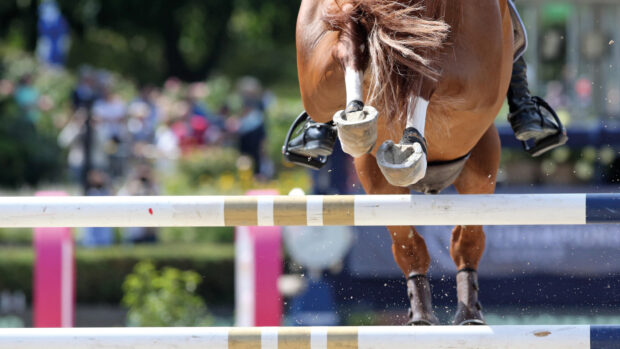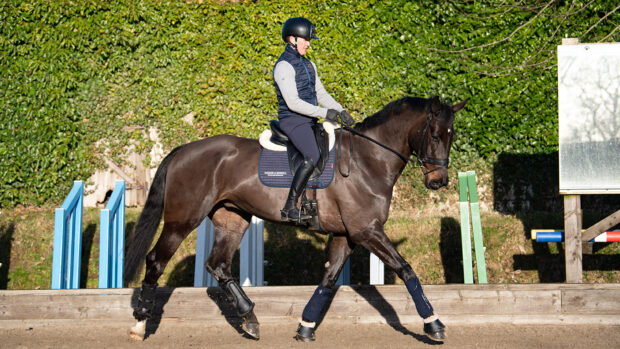Five-star event rider Coral Keen’s shares one of her favourite training exercises for young horses…
Whenever you ride a horse you are always either training them, or untraining them. If you can start them off when they are young with all the right training, it will save you having to untrain those bad habits later down the line.
It’s really important with young horses that you teach them to turn to a fence using different aids, not just your reins. This is something to focus on with any five, or rising five-year-old. You’ll find that if they can learn to follow where you are looking, and react to your body position for direction, it will help you when you are further down the line out competing.
Training your horse to react to your body can help you in every discipline. For example, out on a cross-country course, you may need to jump a drop fence to another obstacle. If you’ve slipped your reins, you may find you don’t have the horse in the contact when you need to turn. For your horse to respond quickly in order to complete the combination, they need to be in tune with your body and able to follow other aids; they should be able to respond before you’ve gathered up your reins.
An exercise that I like to put into action to train reactivity is to find any obstacles that you have available to you: poles, barrels, fences, you can utilise anything. There is no structure to the set-up, you just place four or five elements around the school (or field, dependent on your facilities), with no related distances, and just pop over them on different angles.
If you have poles, start at a walk with poles on the ground. Make sure you have a nice, soft contact so you are letting the horse find their own way, and their balance. You want to be thinking about their footwork and whether they are listening to your body position. See if you can steer your horse over the poles using just your body position, making sure to utilise your focus and the direction you are looking, rather than your reins.
As you start to feel your horse listening to you, you can pick up the pace to a trot, winding round the poles until you feel comfortable to try them in canter. Try some awkward turns, and then increase the poles to little jumps, when you feel your horse is ready.
By the end of this exercise you should feel that your horse has really tuned into you, the way your shoulders turn, where you are looking and the direction your body is facing.
You can have a rein contact, but it should be a soft rein. Try to influence them 95% from your leg and body, and where you are looking. You then have 5% there with your reins if you need to.
Take your time with this, making sure you have good control, whether you are walking, trotting or cantering. Whatever pace you approach the obstacle, you should ride away at the same pace. This will help your horse to learn not to run away from a jump and teaches them balance and discipline.
You can further test your horse by varying the jumps you use. You could try adding in skinny jumps for example, but make sure to keep moving the fences around onto different lines and angles so your horse doesn’t learn where he’s going.
Top tips
Be patient. Patience is key here; this isn’t an exercise to do if you’re in a rush.
Make sure you are being obvious where you are looking, and with the directions you are giving. Turn your hips, your shoulders, and your head – really exaggerate it. Use your peripheral vision to make sure you’re not going to crash into other obstacles or things that may be around the arena. Keep focusing on where you want your horse to go and use your legs and body to direct them.
Listen to your horse, they are going to be asking you where you want them to go, so this is where you’ve got to be really quick with your leg and guide your horse, especially when telling them to go straight again. Think of it as squeezing out a tube of toothpaste in front of you, cuddle the horse with your leg so that your leg is always on. You can increase and decrease the amount of pressure from your leg to encourage them where to go.
Whenever you are training a young horse and they have done something really well, take them in a straight line and halt, giving them lots of praise. It is really important to stop to emphasise this with them, rather than just giving them a pat and carrying on. They don’t always understand what the praise is about. It’s good discipline to halt and make a fuss of them if they have done really well.
If they make a mistake and they don’t understand something, take it back to basics, be very clear with your body language and be patient and precise with what you’re trying to do.
You may also be interested in…

Sarah Bullimore’s figure-of-eight jumping exercise for focus
The five-star eventer shows how the figure-of-eight jumping exercise can help develop balance, rhythm and the ability to land on

Subscribe to Horse & Hound magazine today – and enjoy unlimited website access all year round




